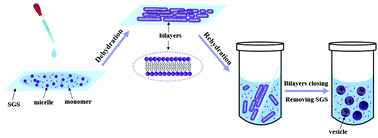Vesicle formation of single-tailed amphiphilic alkyltrimethylammonium bromides in water induced by dehydration–rehydration†
Abstract
We recently found that rough glass surfaces (RGSs) can in situ mediate the micelle-to-vesicle transition in single-component solutions of simple single-tailed amphiphiles (STAs), but only result in a relatively small number of vesicles coexisting with a large number of micelles. In the current work, a dehydration–rehydration (DHRH) method was used to induce the formation of vesicles in the single-component aqueous solutions of alkyltrimethylammonium bromides (CnTABs, n = 12, 14, and 16), a kind of typical cationic STAs. That is, a CnTAB micelle solution dropped on smooth glass surfaces (SGSs) was first dried, and the dried CnTAB aggregates were then rehydrated in a monomer solution of CnTAB. A large population of vesicles and even pure vesicle (or vesicle-dominated) systems were obtained, indicating that the DHRH process could more effectively induce the formation of STA vesicles than RGS in situ mediation. The so-obtained vesicles were characterized using DLS, FF-/cryo-TEM, AFM, SAXS, and fluorescence techniques, and their stability was determined. In addition, the effects of the conditions of DHRH and the chain length of CnTABs on the vesicle formation were examined. It was demonstrated that the vesicles can be formed as long as the concentrations of CnTABs in the rehydrated systems are higher than their critical micelle concentrations. The size and wall thickness of vesicles increase with an increase in chain length. A possible mechanism for the DHRH-induced vesicle formation is proposed: bilayer sheets are formed on SGSs during dehydration, and then detached from the SGSs to form vesicles during rehydration. A highly interdigitated structure of alkyl chains between two leaflets was identified in the bilayers, which probably is the origin of the formation and stability of STA vesicles.



 Please wait while we load your content...
Please wait while we load your content...